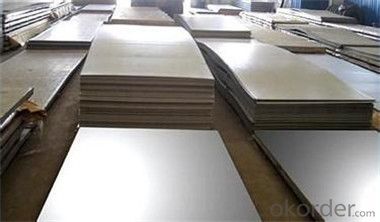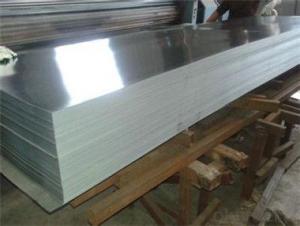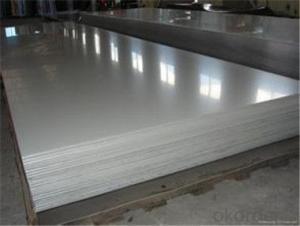Stainless Steel Sheet SS305 with Best Quality in China
- Loading Port:
- Tianjin
- Payment Terms:
- TT OR LC
- Min Order Qty:
- 50 m.t.
- Supply Capability:
- 45555555 m.t./month
OKorder Service Pledge
OKorder Financial Service
You Might Also Like
Item specifice
Description of stainless steel plate:
stanless steel sheet roll
Manufacturer since 2003;
Origin from Baosteel & Tisco;
100% Manufacture's direct deal.
Festures of stainless steel plate:
| Packaging Details: | standard packing to export 4 eye bands and 3 circumferential bands in steel, galvanized metal fluted rings on inner and outer edges, galvanized metal & waterproof paper wall protection disk, galvanized metal & waterproof paper around circumference |
| Delivery Detail: | 15-25 days after received your deposit or to your quantity |
Specifications of stainless steel plate:
Product Name | cr 1219x2438 stanless steel sheet 201 |
standared | JIS, AISI, ASTM, GB, DIN,SUS |
Thickness | 0.2mm~2.5mm |
Size | 1000*2000mm,1219*2438mm or as per customers' request |
Surface finish | 2B, BA, Hair Line, No.1,No.4, Mirror Finish |
Application | Kitchenware, decoration construction and building ornament, product parts manufacturing and stainless steel products tooling and so on |
Payment terms | T/T 30% for deposit, Balance against the copy of B/L; or L/C at sight |
Product Packing | wooden pallet |
Delivery time | within 15-20 working days after we got your 30% deposit |
Attention | FREE SAMPLES can be sent on request. |
Images of stainless steel plate:

FAQ:
1. What is your package?
Packing situation: standard seaworthy packing or as customer required.
2. How long is the lead time?
Delivery time: 45 days after order confirmed.
3. What payment term do you accept?
Payment: T/T or L/C at sight.
- Q:How is steel wire rod used in the manufacturing of wire fences?
- Steel wire rod is used in the manufacturing of wire fences as it serves as the base material for creating the wire strands that form the fence. The wire rod is first drawn to the desired thickness and strength, and then it is further processed to form individual wires that are twisted or woven together to create the fence structure. The high strength and durability of steel wire rod make it an ideal choice for wire fences, providing security, containment, and longevity.
- Q:How does the corrosion resistance of steel wire rod vary with different wire drawing processes?
- The corrosion resistance of steel wire rod can vary with different wire drawing processes. Factors such as the surface finish, the presence of residual stress, and the alteration of the microstructure during the drawing process can influence the corrosion resistance of the wire rod. For example, wire rods that undergo a high-quality wire drawing process with proper cleaning and lubrication techniques can have improved corrosion resistance compared to those subjected to a less controlled or inadequate drawing process. Additionally, the wire drawing process can affect the formation of oxide layers on the surface of the wire rod, which can further impact its corrosion resistance. Overall, the specific wire drawing process employed can significantly impact the corrosion resistance of steel wire rod.
- Q:What are the common production processes for berkelium-coated steel wire rod?
- The common production processes for berkelium-coated steel wire rod typically involve a series of steps. Firstly, the steel wire rod is cleaned and coated with a layer of berkelium using techniques like electroplating or physical vapor deposition. This helps to enhance the properties of the steel wire rod, such as corrosion resistance or conductivity. After the coating process, the wire rod is subjected to heat treatment to ensure proper adhesion and durability of the berkelium coating. Finally, the wire rod may undergo additional processes like cutting, shaping, or surface finishing to meet specific requirements before it is ready for use in various applications.
- Q:How is steel wire rod used in the manufacturing of wire forms for cable trays?
- Steel wire rod is used in the manufacturing of wire forms for cable trays by being drawn through a series of dies to reduce its diameter and increase its length. This process, known as wire drawing, creates a thinner and longer wire that is then shaped, bent, and welded to form the desired wire forms for cable trays. The steel wire rod provides the necessary strength and durability to support the weight of cables and withstand various environmental conditions.
- Q:How are steel wire rods used in the manufacturing of wire baskets for storage?
- Steel wire rods are used in the manufacturing of wire baskets for storage by being shaped, cut, and welded to form the framework of the basket. These rods provide strength and durability to support the weight of items being stored, while also allowing for airflow and visibility.
- Q:What are the different types of heat treatments used for steel wire rod?
- There are several types of heat treatments used for steel wire rods, each with its own purpose and benefits. Some of the most commonly used heat treatments include: 1. Annealing: This process involves heating the steel wire rod to a specific temperature and then slowly cooling it to improve its ductility and reduce internal stresses. Annealing also helps to refine the microstructure of the steel, making it easier to work with and enhancing its mechanical properties. 2. Quenching and tempering: Quenching is the rapid cooling of the steel wire rod after heating it to a high temperature. This process results in a hardened steel with increased strength and hardness. Tempering is then performed by reheating the quenched steel to a lower temperature to reduce brittleness and improve toughness while maintaining some of the hardness achieved during quenching. 3. Normalizing: Similar to annealing, normalizing involves heating the steel wire rod to a specific temperature and then allowing it to cool in still air. This process helps to refine the grain structure of the steel, improve its strength and toughness, and eliminate any internal stresses. 4. Stress relieving: This heat treatment is performed to reduce residual stresses that may have accumulated in the steel wire rod during previous manufacturing processes. By heating the rod to a specific temperature and then cooling it slowly, stress relieving helps to prevent distortion or cracking of the material. 5. Case hardening: Also known as carburizing, this heat treatment involves introducing carbon into the surface layer of the steel wire rod to increase its hardness and wear resistance. The rod is heated in the presence of a carbon-rich atmosphere and then quenched to achieve the desired hardness. Overall, the choice of heat treatment for steel wire rods depends on the desired properties and applications of the final product. Each treatment method has its own advantages and is selected based on the specific requirements of the wire rod.
- Q:How is steel wire rod used in the manufacturing of wire forms for conveyor systems?
- Wire forms for conveyor systems rely on steel wire rod as a vital ingredient in their production. This wire rod acts as the base material from which wire forms are fashioned. To enhance its strength, ductility, and flexibility, the wire rod undergoes a series of mechanical and thermal treatments, such as hot rolling, cold drawing, and annealing. Once the wire rod has been appropriately processed, it is shaped into various wire forms that are specifically tailored for conveyor systems. Examples of these wire forms include wire mesh belts, wire spirals, wire ropes, and wire hooks. Each wire form has a distinct purpose within the conveyor system, whether it be supporting the weight of the conveyed material, guiding the movement of the conveyor belt, or securing and fastening different components of the system. The selection of steel wire rod for manufacturing wire forms for conveyor systems is based on its high tensile strength, corrosion resistance, and durability. These qualities ensure that the wire forms can withstand the demanding operating conditions of conveyor systems, such as heavy loads, high speeds, and exposure to various environmental factors. In conclusion, steel wire rod plays a critical role in the manufacturing of wire forms for conveyor systems by providing the necessary raw material with the required mechanical properties. Its utilization guarantees the dependable and efficient operation of conveyor systems across diverse industries, including mining, manufacturing, transportation, and logistics.
- Q:What are the standard impact strength requirements for steel wire rod?
- The standard impact strength requirements for steel wire rod can vary depending on the specific application and industry standards. However, in general, steel wire rod is expected to possess good impact strength properties to ensure its durability and resistance to breakage under dynamic loading conditions. The impact strength requirements are typically defined by various international standards organizations such as ASTM International, ISO (International Organization for Standardization), and national standards bodies. These standards provide guidelines for determining the impact strength of steel wire rod through standardized testing methods. To meet the standard impact strength requirements, steel wire rod is often subject to impact tests like Charpy or Izod tests. These tests involve striking a notched sample of the wire rod with a pendulum hammer, measuring the energy absorbed during fracture. The results provide a measure of the material's ability to withstand sudden shock or impact. The specific impact strength requirements for steel wire rod can vary depending on factors such as the intended application, industry regulations, and customer specifications. For example, wire rod used in construction may have different impact strength requirements compared to wire rod used in automotive manufacturing. In conclusion, the standard impact strength requirements for steel wire rod are determined by international and national standards organizations and can vary depending on the application. Meeting these requirements ensures that the wire rod possesses the necessary strength and resilience to withstand impact and dynamic loading conditions.
- Q:What is the current global production capacity of steel wire rod?
- The current global production capacity of steel wire rod is approximately 160 million metric tons per year. This capacity is spread across various regions and countries, with major producers including China, India, Japan, the United States, and Russia. The demand for steel wire rod is driven by several industries such as automotive, construction, infrastructure, and manufacturing, which utilize it for a wide range of applications including reinforcement in concrete structures, wire products, and various machinery components. The production capacity of steel wire rod is constantly evolving as new facilities are built, existing ones are expanded, and technological advancements improve efficiency.
- Q:What are the factors that affect the mechanical properties of steel wire rod?
- The factors that affect the mechanical properties of steel wire rod include the composition of the steel, the processing and heat treatment methods used, the presence of impurities or defects, the grain size and structure of the steel, and the applied mechanical forces during processing.
1. Manufacturer Overview |
|
|---|---|
| Location | |
| Year Established | |
| Annual Output Value | |
| Main Markets | |
| Company Certifications | |
2. Manufacturer Certificates |
|
|---|---|
| a) Certification Name | |
| Range | |
| Reference | |
| Validity Period | |
3. Manufacturer Capability |
|
|---|---|
| a)Trade Capacity | |
| Nearest Port | |
| Export Percentage | |
| No.of Employees in Trade Department | |
| Language Spoken: | |
| b)Factory Information | |
| Factory Size: | |
| No. of Production Lines | |
| Contract Manufacturing | |
| Product Price Range | |
Send your message to us
Stainless Steel Sheet SS305 with Best Quality in China
- Loading Port:
- Tianjin
- Payment Terms:
- TT OR LC
- Min Order Qty:
- 50 m.t.
- Supply Capability:
- 45555555 m.t./month
OKorder Service Pledge
OKorder Financial Service
Similar products
New products
Hot products
Related keywords




























